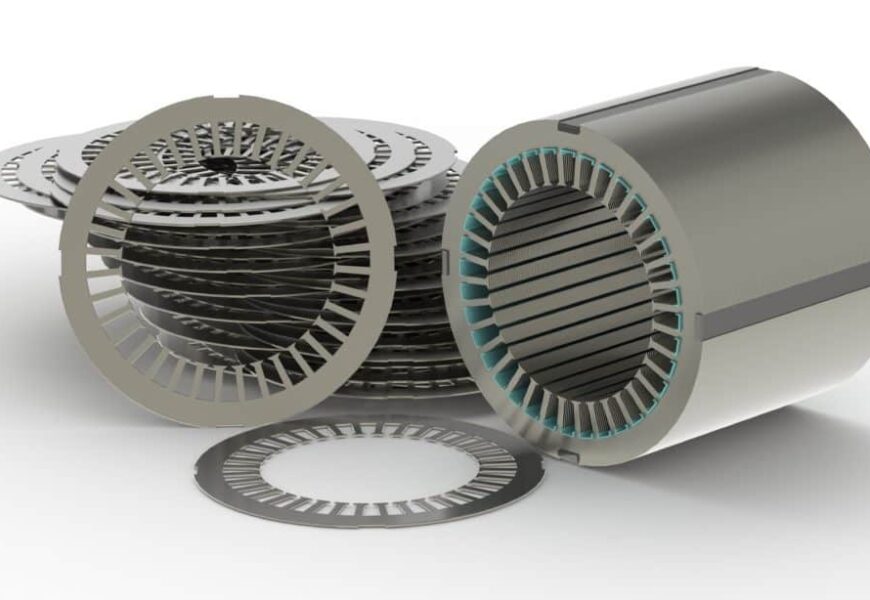Precision is a constant requirement in aerospace manufacturing. Every part, from the smallest fastener to the most complex motor component, must meet exacting standards to ensure reliability and safety. These standards ensure that every element contributes to consistent performance under demanding flight conditions. Let’s explore what makes aerospace lamination stacks meet the highest performance standards.
Material Purity and Consistency
The foundation of performance starts with material quality. Aerospace motor laminations rely on specialized electrical steels with high magnetic permeability and low core loss. These materials are designed to minimize energy dissipation during operation, allowing motors to perform at optimal efficiency. The controlled composition of these steels helps maintain consistent magnetic properties even under extreme thermal and mechanical stress.
Precise material selection also reduces vibration and noise in sensitive aerospace systems. Each lamination is subjected to strict metallurgical testing to verify its grain structure and coating integrity. This helps ensure smooth magnetic flux flow through the motor core. The result is a component that meets stringent aerospace performance standards while maintaining long-term stability.
Precision Stamping and Dimensional Control
Accuracy in manufacturing determines how well laminations align during assembly. In producing precision-engineered lamination stacks, stamping precision directly influences magnetic uniformity and rotor balance. High-speed progressive dies and fine-blanking presses are commonly used to achieve extremely tight tolerances. Even a small deviation in shape or thickness can affect overall efficiency and torque output.
To maintain dimensional consistency, manufacturers use advanced metrology tools such as laser scanning and coordinate measuring machines. These checks confirm that every lamination meets specifications before it enters the stacking or bonding stages. Consistent geometry helps prevent mechanical imbalance, allowing motors to operate with minimal wear.
Advanced Coating Technologies
Surface coatings play a key role in the electrical insulation and corrosion resistance of laminations. Specialized organic or inorganic coatings help prevent short circuits between individual sheets while resisting oxidation in high-temperature conditions. These coatings must maintain insulation integrity throughout repeated thermal cycles.
Coating Types and Their Role
Different coatings serve different performance goals. For example:
- Inorganic phosphate coatings improve heat resistance.
- Organic varnishes enhance insulation and reduce eddy current losses.
- Hybrid coatings combine both traits to balance electrical and mechanical endurance.
The coating application process is carefully monitored for thickness, adhesion, and uniformity. Properly treated laminations help extend motor life while maintaining stable electrical performance under challenging aerospace conditions.
Thermal Stability and Stress Resistance
Temperature fluctuations in aerospace environments can strain materials over time. Laminations must endure constant changes without warping or losing magnetic efficiency. This requires metals with excellent thermal expansion control and coatings that resist cracking or delamination. The goal is to maintain consistent alignment within the stator and rotor assemblies.
Manufacturers perform thermal cycling tests to confirm stability under repeated heating and cooling. Controlled annealing processes may also be used to relieve internal stresses introduced during stamping. This step refines the magnetic grain orientation, enhancing flux density and energy conversion. Together, these methods ensure each lamination maintains its shape and strength throughout extended use.
Precision Assembly and Bonding Processes
Stacking accuracy determines the magnetic integrity of the finished motor core. Each lamination must fit perfectly with the next to eliminate air gaps and maintain uniform magnetic flow. Automated stacking systems help achieve consistent alignment, while bonding adhesives or interlocking tabs keep the structure rigid under high-speed operation.
The bonding technique itself affects vibration resistance and acoustic performance. For aerospace applications, resin-bonded or welded stacks often replace riveted assemblies to minimize imbalance. These techniques produce dense, stable cores that can withstand continuous mechanical and thermal stress. Consistent bonding also aids in reducing noise and extending operational life.
Rigorous Testing and Quality Verification
Before entering service, laminated components undergo a series of evaluations that simulate real-world conditions. Testing may include magnetic property measurement, dimensional verification, insulation resistance, and mechanical endurance trials. Each test ensures compliance with both internal and industry-specific standards such as ISO, AS9100, and NADCAP certifications.
Data from these tests provides valuable insights into process consistency. Statistical process control systems monitor trends and detect deviations early. This allows corrective action before any part enters final assembly. The result is a manufacturing cycle that prioritizes repeatability, traceability, and complete confidence in product reliability.
Meeting the highest performance standards in aerospace manufacturing requires a combination of precision, discipline, and innovation. From material purity to advanced coatings and rigorous testing, every process step contributes to the final reliability of aerospace motor laminations. These components form the foundation of efficient, durable, and safe electric motors used in modern aircraft systems. By maintaining strict control over materials and methods, manufacturers continue to uphold the trust placed in aerospace engineering worldwide.






